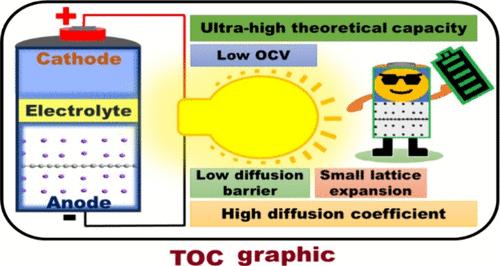萘作为钾离子电池超高容量负极材料的第一性原理研究
IF 3.2
3区 化学
Q2 CHEMISTRY, PHYSICAL
引用次数: 0
摘要
钾离子电池(KIBs)作为一种具有成本效益和可持续性的锂离子电池替代品而备受关注,主要是因为其天然丰富的钾元素及其良好的电化学特性。尽管有这些优点,但开发高效阳极材料仍然是一个重大挑战,主要是因为K+离子的大离子半径,这往往会导致传统阳极材料的结构不稳定。在这种情况下,我们采用基于密度泛函理论(DFT)的第一性原理计算来评估萘,一种新型的二维(2D)聚芳炔基碳结构,作为kib的高性能阳极材料的潜力。我们的计算分析表明,萘提供了1487.53 mAh/g的超高理论容量,显著优于传统阳极,如石墨(273 mAh/g)和其他报道的阳极材料。这种优越的理论存储能力源于其能够通过多层吸附在K48C72单元中稳定容纳多达48个钾离子,每个吸附k离子的平均吸附能在−0.881至−0.133 eV之间。此外,萘具有低钾离子扩散势垒(0.37 eV)和高扩散系数(高达5.502 × 10-7 cm2/s),支持k离子的快速输运和优异的速率能力。钾化作用下结构变形最小(沿a≤0.65%,沿b≤0.73%,面积膨胀≤1.38%),循环条件下结构稳定性强。值得注意的是,钾的吸附还诱导了电子结构从半导体行为向金属行为的转变,从而增强了材料的电子导电性,促进了快速电荷转移。环烷烃的平均低开路电压(OCV)约为0.37 V,具有适合高能量密度存储的平衡电化学分布。总的来说,这些发现突出了萘作为下一代可持续钾离子电池技术进步的有前途和变革性的阳极材料。本文章由计算机程序翻译,如有差异,请以英文原文为准。

First-Principles Investigation of Naphyne as an Ultra-High-Capacity Anode Material for Potassium-Ion Battery
Potassium-ion batteries (KIBs) are gaining attention as a cost-effective and sustainable alternative to lithium-ion batteries, primarily due to the natural abundance of potassium and its favorable electrochemical characteristics. Despite these advantages, the development of highly efficient anode materials remains a significant challenge, mainly because of the large ionic radius of the K+ ion, which tends to induce structural instability in conventional anode materials. In this context, we employ first-principles calculation based on density functional theory (DFT) to evaluate the potential of naphyne, a novel two-dimensional (2D) polyaromatic alkyne-based carbon structure, as a high-performance anode material for KIBs. Our computational analysis reveals that naphyne offers an ultrahigh theoretical capacity of 1487.53 mAh/g, significantly outperforming conventional anodes like graphite (273 mAh/g) and other reported anode materials. This superior theoretical storage capability arises from its ability to stably accommodate up to 48 potassium ions in the K48C72 unit via multilayer adsorption, with average adsorption energies ranging from −0.881 to −0.133 eV per adsorbed K-ion. Moreover, naphyne exhibits a low potassium-ion diffusion barrier (0.37 eV) and high diffusion coefficient (up to 5.502 × 10–7 cm2/s), supporting rapid K-ion transport and excellent rate capability. The structure undergoes minimal structural deformations (≤0.65% along a, ≤ 0.73% along b and ≤ 1.38% area expansion) upon potassiation, indicating robust structural stability under cycling conditions. Notably, potassium adsorption also induces a transition in the electronic structure from semiconducting to metallic behavior, thereby enhancing the material’s electronic conductivity and facilitating fast charge transfer. With an average low open-circuit voltage (OCV) of approximately 0.37 V, naphyne presents a balanced electrochemical profile suitable for high energy density storage. Collectively, these findings highlight naphyne as a promising and transformative anode material for the advancement of next-generation, sustainable potassium-ion battery technologies.
求助全文
通过发布文献求助,成功后即可免费获取论文全文。
去求助
来源期刊

The Journal of Physical Chemistry C
化学-材料科学:综合
CiteScore
6.50
自引率
8.10%
发文量
2047
审稿时长
1.8 months
期刊介绍:
The Journal of Physical Chemistry A/B/C is devoted to reporting new and original experimental and theoretical basic research of interest to physical chemists, biophysical chemists, and chemical physicists.
 求助内容:
求助内容: 应助结果提醒方式:
应助结果提醒方式:


